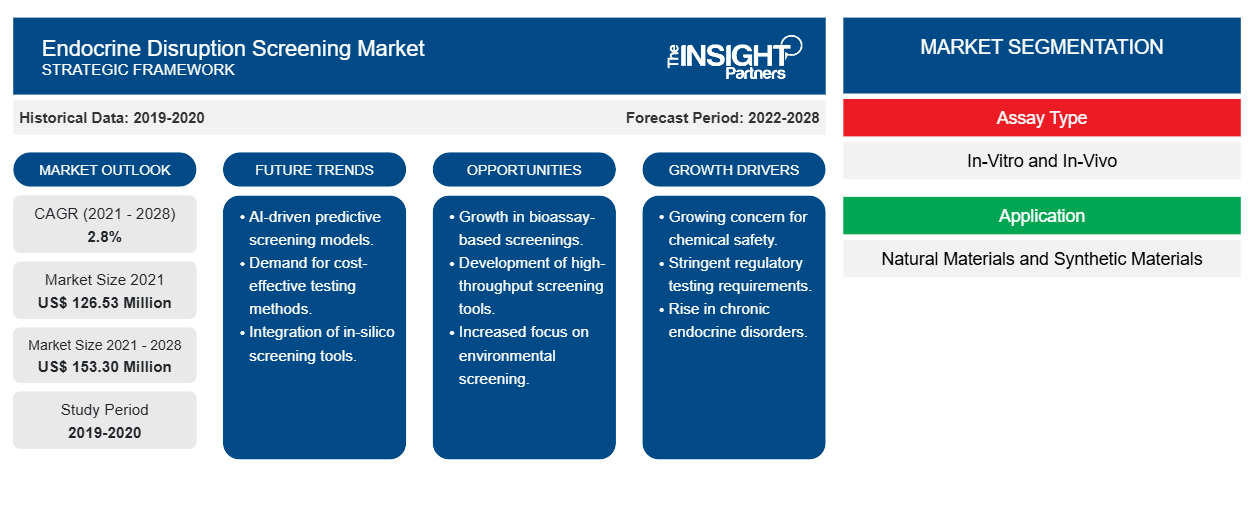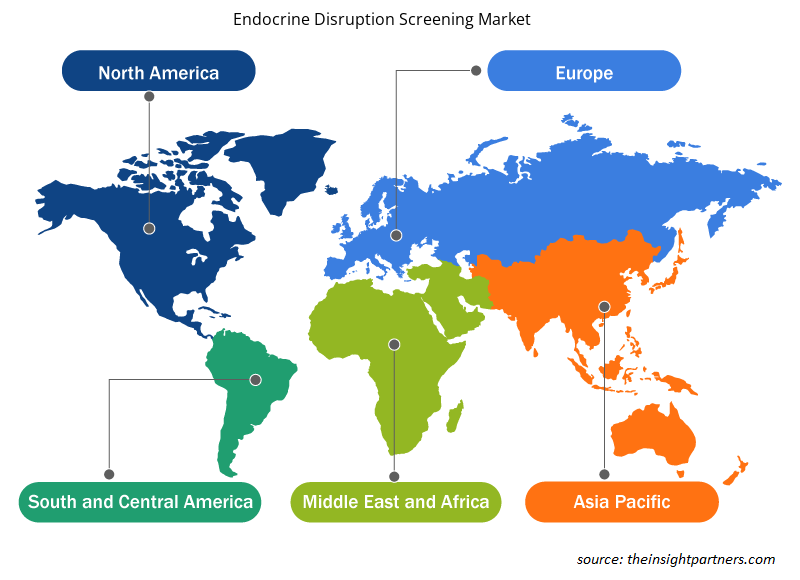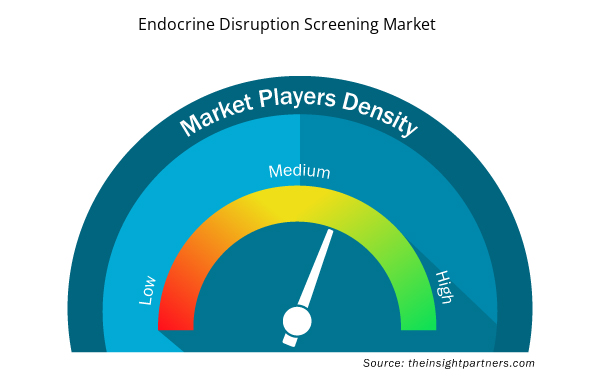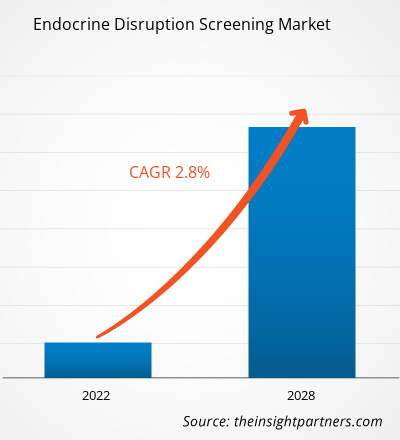The endocrine disruption screening market is projected to reach US$ 153.30 million by 2028 from US$ 126.53 million in 2021; it is expected to grow at a CAGR of 2.8% during 2021 to 2028.
Many chemicals, both natural and man-made, have the potential to imitate or interfere with the endocrine system, which regulates the body's hormones. These chemicals, known as endocrine disruptors, have been linked to developmental, reproductive, brain, immunological, and other disorders. Endocrine disruptors can be present in a variety of ordinary items, such as some plastic bottles and containers, metal food can liners, detergents, flame retardants, food, toys, cosmetics, and pesticides. Pesticides, chemicals, and environmental toxins are screened using a two-tiered method for their potential effect on the oestrogen, androgen, and thyroid hormone systems by the endocrine disruptor screening.
The growth of the endocrine disruption screening market is attributed to the growing research in the biotechnology sector and the rising prevalence of endocrine disorders. However, the high cost of screening technology hampers the market growth.
Customize This Report To Suit Your Requirement
You will get customization on any report - free of charge - including parts of this report, or country-level analysis, Excel Data pack, as well as avail great offers and discounts for start-ups & universities
Endocrine Disruption Screening Market: Strategic Insights

- Get Top Key Market Trends of this report.This FREE sample will include data analysis, ranging from market trends to estimates and forecasts.
Customize This Report To Suit Your Requirement
You will get customization on any report - free of charge - including parts of this report, or country-level analysis, Excel Data pack, as well as avail great offers and discounts for start-ups & universities
Endocrine Disruption Screening Market: Strategic Insights

- Get Top Key Market Trends of this report.This FREE sample will include data analysis, ranging from market trends to estimates and forecasts.
Market Insights
Growing Prevalence of Endocrine Disorders Drives Endocrine Disruption Screening Market
Acromegaly (overproduction of growth hormone), obesity, metabolic syndrome, impaired fasting glucose, impaired glucose tolerance, osteoporosis, osteopenia, mild-moderate hypovitaminosis D, erectile dysfunction, dyslipidemia, and thyroiditis are among the endocrine disorders that have a collective prevalence of at least 5% among the adults in the US. Of these conditions, Males have the highest incidence of erectile dysfunction, while females have the highest incidence of osteopenia/osteoporosis. Diabetes mellitus in children and pituitary adenoma are the least common conditions, affecting less than 1% of the US population. Adrenocortical carcinoma, pheochromocytoma, and pituitary adenomas are the conditions with the lowest incidence. Hyperparathyroidism and thyroid disorders are more common in women. Diabetes mellitus is most prevalent among ethnic minorities. Endocrine and metabolic diseases are among the most common modern human ailments, particularly in the US and other countries implementing ample nutrition and screening programs for high-risk individuals. Endocrine disorders such as hyperparathyroidism, primary and secondary hypogonadism, GH deficiency, and hypothyroidism can lead to other disorders, such as metabolic bone disease and diabetes mellitus. Thus, the growing prevalence and incidence of such conditions propel the demand for endocrine disruption screening products.
Assay Type-Based Insights
The endocrine disruption screening market, by assay type, is bifurcated into in-vitro and in-vivo. The in-vitro segment led the market in 2021, contributing to a market share of 64.45%, and is expected to retain its dominance during the forecast period to account for a market share of 65.73% of the overall revenue generated in 2028.
Application-Based Insights
By application, the endocrine disruption screening market is bifurcated into natural materials and synthetic materials. In 2021, the natural materials segment held a larger share of the market. Moreover, the market for the same segment is expected to grow at a faster CAGR of 3.1% during 2021–2028.
Source of Waste-Based Insights
The endocrine disruption screening market, by source of waste, is segmented into incineration and landfill, agricultural runoff, industrial and municipal effluents, pulp mill effluents, consumer products, and others. In 2021, the incineration and landfill segment held the largest share of the market. Moreover, the market for the same segment is expected to grow at the fastest CAGR of 3.5% during 2021–2028.
Method-Based Insights
The endocrine disruption screening market, by method, is segmented into estrogen receptor (ER) transactivation, androgen receptor (AR) transactivation, androgen receptor (AR) modulation, estrogen receptor-alpha (ER) binding, estrogen receptor beta (ER) binding, androgen receptor (AR) binding, steroidogenesis, aromatase assay, and others. In 2021, the estrogen receptor (ER) transactivation segment held the largest share of the market. Moreover, the market for the same segment is expected to grow at the fastest CAGR of 3.7% from 2021 to 2028.
End-User-Based Insights
The endocrine disruption screening market, based on end use, is segmented into pharmaceutical and biopharmaceutical companies, cosmetics and household product companies, food industry, and chemical industry. In 2021, the pharmaceutical and biopharmaceutical companies segment held the largest share of the market. Moreover, the market for the same segment is expected to grow at the fastest CAGR of 3.3% during 2021–2028.
Product launches and approvals are commonly adopted strategies by companies to expand their global footprints and product portfolios. Moreover, the endocrine disruption screening market players focus on the partnership strategy to enlarge their clientele, which, in turn, permits them to maintain their brand name across the world.
Endocrine Disruption Screening Market Regional Insights
The regional trends and factors influencing the Endocrine Disruption Screening Market throughout the forecast period have been thoroughly explained by the analysts at Insight Partners. This section also discusses Endocrine Disruption Screening Market segments and geography across North America, Europe, Asia Pacific, Middle East and Africa, and South and Central America.

- Get the Regional Specific Data for Endocrine Disruption Screening Market
Endocrine Disruption Screening Market Report Scope
| Report Attribute | Details |
|---|---|
| Market size in 2021 | US$ 126.53 Million |
| Market Size by 2028 | US$ 153.30 Million |
| Global CAGR (2021 - 2028) | 2.8% |
| Historical Data | 2019-2020 |
| Forecast period | 2022-2028 |
| Segments Covered |
By Assay Type
|
| Regions and Countries Covered | North America
|
| Market leaders and key company profiles |
Endocrine Disruption Screening Market Players Density: Understanding Its Impact on Business Dynamics
The Endocrine Disruption Screening Market market is growing rapidly, driven by increasing end-user demand due to factors such as evolving consumer preferences, technological advancements, and greater awareness of the product's benefits. As demand rises, businesses are expanding their offerings, innovating to meet consumer needs, and capitalizing on emerging trends, which further fuels market growth.
Market players density refers to the distribution of firms or companies operating within a particular market or industry. It indicates how many competitors (market players) are present in a given market space relative to its size or total market value.
Major Companies operating in the Endocrine Disruption Screening Market are:
- CREATIVE BIOARRAY
- XENOMETRIX AG
- CHARLES RIVER
- EUROFINS SCIENTIFIC
- SMITHERS
Disclaimer: The companies listed above are not ranked in any particular order.

- Get the Endocrine Disruption Screening Market top key players overview
The report segments endocrine disruption screening market as follows
Endocrine Disruption Screening Market – by Assay Type
- In-Vitro
- In-Vivo
Endocrine Disruption Screening Market – by Application
- Natural Materials
- Synthetic Materials
Endocrine Disruption Screening Market – by Sources of Waste
- Incineration and Landfill
- Agricultural Runoff
- Industrial and Municipal Effluents
- Pulp Mill Effluents
- Consumer Products
- Others
Endocrine Disruption Screening Market – by Method
- Estrogen Receptor (ER) Transactivation
- Androgen Receptor (AR) Transactivation
- Androgen Receptor (AR) Modulation
- Estrogen Receptor-Alpha (ER-alpha) Binding
- Estrogen Receptor Beta (ER-beta) Binding
- Androgen Receptor (AR) Binding
- Steroidogenesis
- Aromatase Assay
- Others
Endocrine Disruption Screening Market – by End User
- Pharmaceutical and Biopharmaceutical Companies
- Chemical Industry
- Food Industry
- Cosmetics and Household Product Companies
Endocrine Disruption Screening Market – by Geography
- North America
- US
- Canada
- Mexico
- Europe
- UK
- Germany
- France
- Italy
- Spain
- Rest of Europe
- Asia Pacific
- China
- Japan
- India
- Australia
- South Korea
- Rest of Asia Pacific
- Middle East and Africa
- UAE
- Saudi Arabia
- South Africa
- Rest of Middle East and Africa
- South and Central America
- Brazil
- Argentina
- Rest of South and Central America
Company Profiles
- CREATIVE BIOARRAY
- XENOMETRIX AG
- CHARLES RIVER LABORATORIES, INC.
- EUROFINS SCIENTIFIC Ltd.
- SMITHERS
- SGS SA
- JRF GLOBAL
- MéRIEUX NUTRISCIENCES
- ALPHA ANALYTICAL INC.
- Historical Analysis (2 Years), Base Year, Forecast (7 Years) with CAGR
- PEST and SWOT Analysis
- Market Size Value / Volume - Global, Regional, Country
- Industry and Competitive Landscape
- Excel Dataset



Report Coverage
Revenue forecast, Company Analysis, Industry landscape, Growth factors, and Trends

Segment Covered
Assay Type, Application, Sources of Waste, Method, and End User, and Geography

Regional Scope
North America, Europe, Asia Pacific, Middle East & Africa, South & Central America

Country Scope
Argentina, Australia, Brazil, Canada, China, France, Germany, India, Italy, Japan, Mexico, Saudi Arabia, South Africa, South Korea, Spain, United Arab Emirates, United Kingdom, United States
Frequently Asked Questions
The global endocrine disruption screening market is expected to reach US$ 153.30 million by 2028 from US$ 126.53 million in 2021. The market is estimated to grow with a CAGR of 2.8% from 2021-2028.
Regulatory agencies throughout the world are grappling with the task of assessing the hazards and dangers to human and ecosystem health that may come from exposure to substances that disrupt the normal functioning of endocrine systems. The rapidly rising number of compounds in commerce, along with the dependence on conventional, expensive animal tests for hazard assessment – frequently with insufficient sensitivity to many critical processes of endocrine disruption – poses persistent problems for chemical management. As a result, there are only a few compounds for which there is enough evidence to determine whether there is endocrine toxicity, and hence only a few substances with full hazard categorization. To address this issue, regulatory assessment of endocrine disrupting chemicals (EDCs) is benefiting from a toxicology revolution focused on New Approach Methodologies (NAMs) to more rapidly identify, prioritize, and assess the potential risks from chemical exposure using novel, more efficient, and mechanistically driven methodologies, and tools.
The Asia Pacific region is expected to be the fastest-growing region among all other regions. The market is this region is expected to grow significantly in countries such as China, Japan, South Korea, and India. The growth of the market in this region is expected to grow at a faster pace owing to factors such as high prevalence of this hormonal changes, and the rise in healthcare awareness. Additionally, developing healthcare infrastructure and increasing investments are projected to drive the Asia Pacific endocrine disruption screening market during the forecast period.
The growth of the endocrine disruption screening market is mainly attributed to factors such as the increasing prevalence of endocrine disorders coupled with rising incidence of diabetes. However, the high cost of screening technology and devices is hindering the market growth. In July 2021, DDA platform, the division of Creative Bioarray, launched a wide range of genotoxicity testing services (non-GLP) into the service segment of in vitro toxicity services which is contributing to the growth of the target market. Such strategic steps are also projected to drive the market growth.
Many chemicals, both natural and man-made, can imitate or interfere with the endocrine system, which regulates the body's hormones. These chemicals, known as endocrine disruptors, have been related to developmental, reproductive, cognitive, immunological, and other issues. Many ordinary products include endocrine disruptors, such as some plastic bottles and containers, metal food can liners, detergents, flame retardants, food, toys, cosmetics, and pesticides. Some hormone-disrupting compounds take a long time to degrade in the environment. As a result of this trait, they can become dangerous over time. Pesticides, chemicals, and environmental toxins are screened using a two-tiered method for their potential effect on the estrogen, androgen, and thyroid hormone systems by the endocrine disruptor screening.
Trends and growth analysis reports related to Life Sciences : READ MORE..
The List of Companies - Endocrine Disruption Screening Market
- CREATIVE BIOARRAY
- XENOMETRIX AG
- CHARLES RIVER
- EUROFINS SCIENTIFIC
- SMITHERS
- SGS SA
- JRF GLOBAL
- MéRIEUX NUTRISCIENCES
- ALPHA ANALYTICAL

 Get Free Sample For
Get Free Sample For